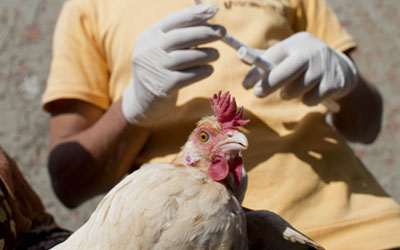
TAD-Info module established and operationalized through USAID-funded projects to strengthen the national capacity for H5N1 epidemio-surveillance epidemiological networking between GOVS and local veterinary services.

During 2014/2015, Egypt witnessed an unprecedented upsurge of H5N1 HPAI human cases. Based on data from the Ministry of Health (MoH), 35% of H5 HPAI of these human cases were linked to the traditional practices of slaughtering birds in the household sector.

Since 2007, ECTAD has been fully supporting the development of the diagnostic capacity of NLQP through international and national training courses for lab staff to enhance their skills for more efficient detection and characterization.
Success stories

Highly Pathogenic Avian Influenza (HPAI) has been one of Egypt’s main public health threats since 2006. ECTAD Egypt has been supporting the General Organization for Veterinary Services (GOVS) and the Animal Health Research Institute (AHRI) in the setting up and implementing of the Avian Influenza surveillance program, at that time focusing mainly on H5N1. This program has served as an effective early warning tool, enabling the veterinary authority to early detect and rapidly respond to new virus strains.

In close collaboration with the International Livestock Research Institute (ILRI), and the Ministry of Agriculture and Land Reclamation (MoALR), ECTAD started a participatory disease surveillance (PDS) program in 2008. The program aimed to strengthen the national capacity for H5N1 surveillance in Egypt. The program was later renamed to Community-Based Animal Health Outreach (CAHO) to include risk communication functions and outbreak investigation.

Unsafe methods of disposal of daily poultry mortalities in Egypt pose great environmental and public health threats. 21,000 Egyptian small and mid-scale broiler farmers dispose of about 39 million dead birds in an unsafe manner.

In 2011, ECTAD laid the foundation of establishing the first One health (OH) collaboration in Egypt by founding the 4-Way Linking Initiative (4WL). Through this initiative, FAO, World Organization for Animal Health (WOAH, previously named OIE), and World Health Organization (WHO) brought together the epidemiology and laboratory components of the human and animal health sectors from the Ministry of Health (MoH) and the Ministry of Agriculture and Land Reclamation (MoALR), and Ministry of Environment (MoE).

